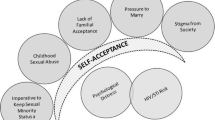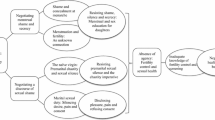Abstract
In New York City, HIV is increasingly concentrated in the foreign-born population, necessitating a greater exploration of the mechanisms through which changes in behavior and risk for HIV occur within migrant populations. Interviews were conducted with 22 Honduran-born Garifuna women to explore partnerships, sexual behaviors, and HIV risk in the context of migration, and transcripts were coded by thematic analysis procedures. Five themes emerged: (1) migration ends relationships, (2) new relationships in the U.S. form because of material and psychological needs, (3) secondary sexual partnerships are a man’s issue, (4) female secondary sexual partnership participation as a marker of equality, and (5) monogamy due to a lack of time. These findings suggest that greater attention be paid to women’s participation in secondary sexual partnerships for purposes other than economic need, and demonstrate a need for HIV interventions that are based in an understanding of how the social context of migration affects sexual behaviors.
Similar content being viewed by others
References
United States Census Bureau. U.S. Census Bureau State and Country QuickFacts: New York (city), New York. Available at: http://quickfacts.census.gov/qfd/states/36/3651000.html. Accessed 2 Aug 2011.
Wiewel E, Nasrallah H, Hanna D, Shepard C, Torian C, Begier E. HIV diagnosis and care initiation among foreign-born persons in New York City, 2001–2007. Paper presented at: 16th conference on retroviruses and opportunistic infections, February 2009, Montreal, Canada.
Singh YN, Malaviya AN. Long distance truck drivers in India: HIV infection and their possible role in disseminating HIV to rural areas. Int J STD AIDS. 1994;5:137–8.
Chirwa WC. Migrant labour, sexual networking and multipartnered sex in Malawi. Transit Rev. 1997;7:5–15.
Lacerda R, Gravato N, McFarland W, Rutherford G, Iskrant K, Stall R, Hearst N. Truck drivers in Brazil: prevalence of HIV and other sexually transmitted diseases, risk behavior and potential for spread of infection. AIDS. 1997;11:S15–9.
Ramjee G, Gouws E. Prevalence of HIV among truck drivers visiting sex workers in KwaZulu-Natal. South Africa. Sex Transm Dis. 2002;29:4–49.
Parrado EA, Flippen CA. Migration and sexuality: a comparison of Mexicans in sending and receiving communities. J Soc Issues. 2010;66:175–95.
Wolffers I, Fernandez I, Verghis S, Vink M. Sexual behaviour and vulnerability of migrant workers for HIV infection. Cult Health Sex. 2002;4:459–73.
Yang X. Migration, gender, and STD risk: a case study of female temporary migrants in Southwestern China. In: Sleigh AC, Leng CH, Yeoh BSA, editors. Population dynamics and infectious diseases in Asia. Hackensack: World Scientific Publishing; 2006. p. 245–70.
Hoffman S, Higgins JA, Beckford-Jerrett ST, Augenbraun M, Bylander KE, Mantell JE, Wilson TE. Contexts of risk and networks of protection: NYC West Indian immigrants’ perceptions of migration and vulnerability to sexually transmitted diseases. Cult Health Sex. 2011;13:513–28.
Buckley CJ. HIV in the Caucasus: the importance of family networks in understanding women’s risk settings. In: Women migrants and HIV/AIDS: An anthropological approach. Proceedings of the round table held on 20 November 2004 at UNESCO, Paris. Available at: http://unesdoc.unesco.org/images/0014/001400/140007E.pdf. Accessed 5 Feb 2011.
Brockerhoff M, Biddlecom AE. Migration, sexual behavior and risk of HIV in Kenya. Int Migr Rev. 1999;4:833–56.
Yang X, Xia G. Gender, migration, risky sex, and HIV infection in China. Stud Fam Plann. 2006;37:241–50.
Centers for Disease Control and Prevention. HIV surveillance report. Atlanta: Centers for Disease Control and Prevention; 2009.
González NL. Sojourners of the Caribbean: ethnogenesis and ethnohistory of the Garifuna. Urbana: University of Illinois Press; 1988.
Miller LR. Bridges: Garifuna migration to Los Angeles [dissertation]. Irvine: University of California; 1993.
Cantor E. Remittances and development: lessons from the Garifuna transnational community. Eschborn, Germany: Deutsche Gesellschaft fur Technische Zusammenarbeit; 2005.
DeFray JB. Identity matters: immigration and the social construction of Identity in Garifuna Los Angeles [dissertation]. San Diego: University of California; 2004.
Joint United Nations Programme on HIV/AIDS (UNAIDS). 2008 Report on the global AIDS epidemic. Available at: http://www.unaids.org/en/dataanalysis/epidemiology/2008reportontheglobalaidsepidemic/.
Paz-Bailey G, Morales-Miranda S, Jacobson JO, Gupta SK, Sabin K, Mendoza S, Paredes M, Alvarez B, Monterroso E. High rates of STD and sexual risk behaviors among Garifunas in Honduras. J Acquir Immune Defic Syndr. 2009;51:S26–34.
García JM, Salavarría N, Valentín D, Ramirez D, Sierra M. Proyecto “Educación preventiva y fortalecimiento de la respuesta local en las comunidades Garífuna.” In: Aspectos sociodemográficos, conocimientos, creencias, actitudes y prácticas relacionadas con la transmissión de ITS/VIH en las comunidades Garífunas [de la costa norte]. Tegucigalpa, Honduras: Asociación El Buen Pastor, Organización Panamericana de la Salud/ONUSIDA, Departamento de ETS/SIDA/TB, Secretaría de Salud de Honduras; 2000.
Stansbury JP, Sierra M. Risk, stigma and Honduran Garifuna conceptions of HIV/AIDS. Soc Sci Med. 2004;59:457–71.
Sabin M, Luber G, Sabin K, Monterroso E. Rapid ethnographic assessment of HIV/AIDS among Garifuna communities in Honduras: informing HIV surveillance among Garifuna women. J Hum Behav Soc Environ. 2008;17:237–57.
Buszin J, Nieto-Andrade B, Rivas J, Longfield P. Multiple partnerships and HIV among the Garifuna minority population in Belize. Paper presented at: Population Association of America Annual Meeting; April 2009; Detroit, Michigan.
Kerns V. Women and the ancestors: Black Carib kinship and ritual. Urbana: University of Illinois Press; 1997.
New York City Department of Health and Mental Hygiene. New York City HIV/AIDS Annual surveillance statistics 2009. Available at: http://www.nyc.gov/html/doh/html/dires/hivepi.shtml. Accessed 2 Aug 2011.
Boeije H. A purposeful approach to the constant comparative method in the analysis of qualitative interviews. Qual Quant. 2002;36:391–409.
Bernard HR, Ryan GW. Analyzing qualitative data. Systematic approaches. Los Angeles, California: Sage; 2010.
Grieb SMD. Gender, transnational migration and HIV risk among the Garinagu of Honduras and New York City [dissertation]. Gainesville: University of Florida; 2009.
Coelho R. Los negros Caribes de Honduras. 2nd ed. Tegucigalpa, Honduras: Editorial Guaymuras; 1995.
Beaucage P. Economic anthropology of the Black Carib (Garifuna) of Honduras [dissertation]. London School of Economics: London; 1970.
Mercer A, Khanam R, Gurley E, Azim T. Sexual risk behavior of married men and women in Bangladesh associated with husband’s work migration and living apart. Sex Transm Dis. 2007;34:265–73.
Opio A, Mishra V, Hong R, Musinguzi J, Kirungi W, Cross A, Mermin J, Bunnell R. Trends in HIV-related behaviors and knowledge in Uganda, 1989-2005: evidence of a shift toward more risk-taking behaviors. J Acquir Immune Defic Syndr. 2008;49:320–6.
Broude GJ. Extramarital sex norms in cross-cultural perspective. Behav Sci Res. 1980;15:181–218.
Jankowiak W, Nell MD, Buckmaster A. Managing infidelity: a cross-culture perspective. Ethnology. 2002;41:85–101.
Winking J, Kaplan H, Gurven M, Ruças S. Why do men marry and why do they stray? Proc R Soci. 2007;274:1643–9.
Jankowiak W, Hardgrave MD. Individual and societal response to sexual betrayal: a view from around the world. Electronic J Hum Sex. 2007;10.
Hirsch JS, Meneses S, Thompson B, Negroni M, Pelcastre B, del Rio C. The inevitability of infidelity: sexual reputation, social geographies, and marital HIV risk in rural Mexico. Am J Public Health. 2007;97:986–96.
Wardlow H. Men’s extramarital sexuality in rural Papua New Guinea. Am J Public Health. 2007;97:1006–14.
Smith DJ. Modern marriage, men’s extramarital sex, and HIV risk in southeastern Nigeria. Am J Public Health. 2007;97:997–1005.
Parikh SA. The political economy of marriage and HIV: the ABC approach, “safe” infidelity, and managing moral risk in Uganda. Am J Public Health. 2007;97:1198–208.
Phinney HM. “Rice is essential but tiresome; you should get some noodles”: Doi Moi and the political economy of men’s extramarital sexual relations and marital HIV risk in Hanoi, Vietnam. Am J Public Health. 2008;98:650–60.
Wardlow H. Wayward women: sexuality and agency in a New Guinea Society. Berkeley: University of California Press; 2006.
Tawfik L, Watkins SC. Sex in Geneva, sex in Lilongwe, and sex in Balaka. Soc Sci Med. 2007;64:1090–101.
Türmen T. Gender and HIV/AIDS. Int J Gynaecol Obstet. 2003;82:411–8.
Author information
Authors and Affiliations
Corresponding author
Appendix: Selected Interview Questions
Appendix: Selected Interview Questions
Describe a typical day for you. Descríbame un día típico en su vida.
Are Garifuna women in NYC any different than Garifuna women back in Honduras? Is so, how? ¿Son diferentes las mujeres Garifunas en Nueva York que las mujeres Garifuna de Honduras? ¿Cómo?
What has been the hardest part about your migration experience? ¿Qué ha sido la más difícil de emigrar?
Has migration affected your interactions with men in any way? ¿Ha afectado la migración su relatión con los hombres?
What qualities do you like in a man? ¿Qué cualidades te gustan en un hombre?
Is it important to have a partner? ¿Es importante tener pareja/compañero?
Can you tell me about your current/last partner and your relationship with him? ¿Me puede hablar sobre su pareja actual/pasado y su relación con él?
How do you feel about men being faithful to their female partners? ¿Qué piensa sobre la fidelidad del hombre?
How do you feel about your partner being faithful to you? ¿Qué piensa sobre la fidelidad de su pareja?
Since learning about HIV/AIDS, do you think people’s behaviors have changed? Desde que se aprendió sobre la existencia del VIH/sida ¿piensa usted que ha cambiado el comportamiento de las personas?
Have you changed your behavior in any way? ¿Ha cambiado su comportamiento?
Is there anything else you would like to add about sexual relationships or HIV/AIDS? ¿Hay alguna otra cosa que quisiera agregar sobre las relaciones sexuales o el VIH/sida?
Rights and permissions
About this article
Cite this article
Grieb, S.M.D., Nielsen-Bobbit, J. Monogamy and Secondary Sexual Partnerships Among Afro-Amerindian Immigrant Women in New York City: A Qualitative Study. J Immigrant Minority Health 15, 365–371 (2013). https://doi.org/10.1007/s10903-012-9615-5
Published:
Issue Date:
DOI: https://doi.org/10.1007/s10903-012-9615-5




